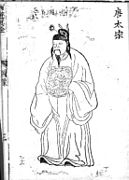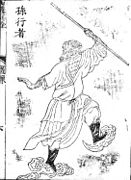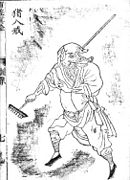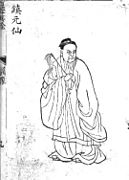The journey to the West
| The journey to the West | |
|---|---|
| Painting in Summer Palace 1 , Beijing 2005 | |
| Chinese spelling | |
| Long characters | 西遊記 |
| Abbreviation | 西游记 |
| Pinyin | Xī yóu jì |
| Wade-Giles | Hsi 1 Yu 2 Chi 4 |
| Jyutping | Sai 1 jau 4 Gei 3 |
| Japanese spelling | |
| Go-on reading | |
| Kanji | 西遊記 |
| Kana | せ い ゆ う き |
| Hepburn | Seiyūki |
| Kunrei | Seiyūki |
| Kan-on reading | |
| Kanji | 西遊記 |
| Kana | さ い ゆ う き |
| Hepburn | Saiyūki |
| Kunrei | Saiyūki |
| Korean spelling | |
| Hangul | 서유기 |
| Hanja | 西遊記2 |
| RR | Seoyugi |
| MR | Sŏyugi |
| Yale | Seyugi |
The Journey to the West ( Chinese 西遊記 / 西游记 , Pinyin Xī yóu jì , W.-G. Hsi Yu Chi , Jyutping Sai 1 jau 4 gei 3 ), written in the 16th century at the time of the Ming dynasty by Wu Cheng 'en ( 吳承恩 / 吴承恩 ), is a Chinese novel and is one of the four classic novels in Chinese literature . It deals with the principle of travel, combined with Chinese folk tales, legends and themes of Buddhism and Daoism and tells in particular of the journey of a monk from the Tang period to a land called the "Western Heaven" ( 西天 , Xītiān ), the "western" of the ancient world China is located in what is now India , from where he is supposed to bring Buddha's holy writings ( Sutra ) to China .
content
The first part tells of the stone monkey Sun Wukong ( 孫悟空 / 孙悟空 ), born of heaven and earth ( 天地 , tiāndì - “meaning: universe, mother nature”), who gains supernatural abilities and later even immortality , becomes king of the apes makes and causes turmoil in heaven. The Heavenly Emperor - also known as the "Jade Emperor" - sends all his troops against Sun Wukong, but he succeeds again and again - less through his strength, but mostly through cunning - to overwhelm the heavenly hosts or to escape them. Finally, the Heavenly Emperor Buddha calls for help, who succeeds in outsmarting the Monkey King: He creates a mountain range from the five elements water, fire, wood, earth and metal and covers Sun Wukong with them; an additional spell on a rock keeps the monkey king in it. Only 500 years later is he freed by the Buddhist monk Xuanzang ( 玄奘 ), who accepts him as a student, after which he accompanies him on his journey to the face of the Buddha for ten years.
This journey is described in detail in the second part of the book. The first part is based on the legend of the Monkey King, who embodied the rebel who rose up against the authorities during the Warring States' era. That is why the monkey king has been one of the most popular folk characters for more than 1,500 years and The Journey to the West is one of the folk epics of China (see also The Robbers from Liang Schan Moor ).
The fictional character of the monk Tang Seng ( 唐僧 - " Tang monk"), with the surname Sanzang ( 三藏 - " Tripitaka ") - hence also Tang Sanzang ( 唐三藏 - "Tripitaka monk from Tang China ") is called on accompanied on his journey by three other people. Of these, Sun Wukong, the king of the apes, with his mixture of impetuous behavior, great courage, strange humor and sometimes surprising wisdom represents the actual main character of the story. Sun Wukong is one of the most famous mythical creatures of China and could have originated with the Hindu To be related to the monkey god Hanuman .
Other companions of the monk Tang Seng are Shā Wùjìng ( 沙 悟淨 / 沙 悟净 ), a water or half demon - depending on the source - with a terrifying face, and Zhu Bajie ( 豬 八戒 / 猪 八戒 ), by monk Tang Seng Zhu Wuneng ( 豬悟 能 / 猪 悟 能 ) called, a mixture of pigs and humans . Both are former heavenly dignitaries punished for their wrongdoings: Shā Wùjìng was the general who blew the curtain and destroyed a valuable vase , Zhu Bajie the marshal of the heavenly sailing fleet, who was kicked by the wheel of reincarnation for his flirt with the moon goddess Chang'e and got a pig as a mother. Tang Seng's horse was originally the third prince of the Dragon King ( 龍王 三 太子 / 龙王 三 太子 ), who set his father's pearl on fire and was sentenced to death for it. Tang Seng himself is the reincarnation of a disciple of the Buddha named "Golden Cicada" ( 金蟬子 / 金蝉子 , Jīnchánzǐ ), who fell asleep during a lecture and was therefore cast out. The 81 ordeals that Tang Seng travels mainly during the journey are an integral part of his repentance ; so the final test at the end is ordered by the Buddha himself.
Apart from the fantastic content of the story, The Journey West is based on the true story of the Chinese monk Xuanzang - aka Tang Seng, nicknamed Sanzang , recorded in the records of the Great Tang Empire of the Western Regions - 大唐 西域 記 / 大唐 西域记 , Dà Táng Xīyùjì , who traveled along the Silk Road from China to India - that is, to the west - at the time of the Tang Dynasty , in order to research the teachings of Buddhism and to bring it back to his homeland - “ China of the Tang times ” to propagate.
- Characters of history
Emperor Tang Taizong
Xuanzang with horse
Demon - Baigujing
Illustration of the 18th century.
- annotation
Adaptations
The story is one of the most important narratives in China and is known far beyond the country's borders. It is the basis of countless films , books , comics and computer games .
- The classic Chinese animated film The Monkey King (1965) retells the story.
- In 1978, Milo Manara became famous for his comic book adaptation of The Monkey King (with the text by Silverio Pisus, first published in the comic book Pilote ).
- In the 1980s, CCTV produced a fairly faithful TV series, the 25 episodes of which cover a good half of the 100 chapters of the book and which was broadcast in full in 1988. For the missing chapters, 16 more episodes were filmed between 1998 and 1999 and broadcast in 2000.
- The well-known manga series Dragon Ball (1984-1995) is loosely based on the adventures of the monkey king Son Gokū ( Japanese 孫悟空 そ ん ・ ご く う , Chinese Sūn Wùkōng).
- The manga Saiyuki ( Japanese 最 遊記 さ い ゆ う き , 1995) or its spin-off and its anime television series from 2000 with the title Gensoumaden Saiyuki , which comprises 50 episodes, take over almost all elements of the story. Another anime called Alakazam - King of Beasts ( Saiyūki ) is also based on Chinese history.
- In 2001 Monkey King - A warrior between the worlds appeared as a "mini-series" (2 episodes, a total of about 3 hours). Thomas Gibson plays the American businessman Nicholas Orton, who is supposed to prevent the world from turning back 500 years. To do this, he must save the manuscript "Journey to the West" from destruction and is accompanied by Sun Wukong, Zhu Bajie and Sha Wujing.
- On June 28, 2007, the opera Monkey: Journey to the West by the Chinese actor and director Chen Shi-zheng, the British musician Damon Albarn and the artist Jamie Hewlett premiered in Manchester. The piece is a mixture of Chinese opera and modern artistry circus with western influences.
- On October 5, 2010, the game Enslaved: Odyssey to the West , developed by Ninja Theory, was released for Playstation 3 and Xbox 360 , which transfers the story into a post-apocalyptic version of the real world, in which the character Monkey joins his unwilling friend Trip Must accompany family. Monkey himself is human, but has an unmistakable, ape-like character design. The game itself was well received by the press.
- In the film The Forbidden Kingdom (2008) the character of the Monkey King also appears. The main features of the film's character match those of the Monkey King from the historical narratives, but the actual film plot uses the character detached from the historical context.
- In the Webtoon The God of High School , Sun Wukong plays one of the leading roles under the name Jin Mo-Ri. The events from "The Journey to the West" are referred to several times.
- In March 2011 the successful Chinese producer Zhang Jizhong announced that he wanted to film the work as a trilogy and in 3D together with James Cameron and Guillermo del Toro . The cost so far is an estimated $ 300 million.
- In 2014, The Monkey King was a big budget film production and featured Donnie Yen as the Monkey King.
- In 2016, The Monkey King 2 was a sequel this time with Aaron Kwok in the lead role.
- In 2018, the Journey to the West was a serial adaptation on Netflix.
- In May 2020, LEGO will be releasing themed building kits based on the Chinese novel under the name Monkie Kid .
expenditure
(in chronological order)
German
- The monkey Sun Wukong. In: Chinese fairy tales, collected and translated from the Chinese by Richard Wilhelm. Eugen Diederichs, Jena 1914, chapter 100.
- Wu Cheng'en: Monkey's Pilgrimage - A Chinese Legend. Translation by Georgette Boner and Maria Nils from English by Arthur Waley. Artemis-Verlag, Zurich 1947.
- New edition: The rebellious monkey. The trip to the west. With an essay on understanding the work of Hellmut Wilhelm . Rowohlt's Classics of Literature, Reinbek 1961
- New edition: Monkey's Pilgrimage. Hugendubel, Munich 1980.
- Paperback: Monkeys Pilgrimage. The fantastic journey of the monkey Monkey: a book made from the essences of heaven and earth. Goldmann TB 6536. Goldmann Verlag, Munich 1983, ISBN 3-442-06536-4
- Excerpts from various picture books in the publishing house for foreign language literature , Beijing 1979–1986: Sun Wukong is born; The True and False Sun Wukong; Turmoil in heaven; Sun Wukong is converted to Buddhism; Sun Wukong outwits the princess with the iron fan.
- Wu Tschöng-ön: The pilgrimage to the west. Translated from the Chinese and shortened by Johanna Herzfeldt . Greifenverlag, Rudolstadt (Thuringia) 1962
- Wu Cheng'en: Journey to the West. (Picture book; edited by John Zhou.) Ost-Zhou, Bad Pyrmont 2005, ISBN 3-9809443-3-6
- Anonymous: The journey to the west. A classic Chinese novel. With 100 woodcuts based on old issues. Translated and commented by Eva Lüdi Kong . Reclam, Stuttgart 2016, ISBN 978-3-15-010879-6 (first complete German translation; awarded the Leipzig Book Fair 2017 prize, category: translation ).
English
- Wu Cheng'en: Monkey. Translated by Arthur Waley . Allen & Unwin, London 1953 (abridged version).
- Wu Cheng'en: Journey to the west. Translated by Anthony F. Yu. 4 volumes. University of Chicago Press, 1977 ff. Revised edition 2012.
- Wu Cheng'en: Journey to the west. Translated by William JF Jenner. 4 vols. Foreign Language Press, Beijing 1993. New edition 2010, ISBN 978-7-119-01663-4 .
literature
- Thomas Zimmer: The Chinese novel of the late imperial era. Walter Gruyter, Berlin / Boston 2002, ISBN 978-3-11-916478-8 / ISBN 978-3-598-44111-0 , pp. 290–338
- Victor H. Mair (Ed.): The Shorter Columbia Anthology of Traditional Chinese Literature . Columbia University Press, New York, NY 2001, ISBN 978-0-231-50562-8 , pp. 566-581
- Andrew Plaks: The Four Masterworks of the Ming Novel . Princeton University Press, Princeton NJ 1987, pp. 183-276, ISBN 0-691-06708-2 .
- Xiaolian Liu: A Journey of the Mind: The Basic Allegory in Hou Xiyou ji . Chinese Literature: Essays, Articles, Reviews (CLEAR), Volume 13 (Dec., 1991), pp. 35-55 ( JSTOR 495052 )
See also
Web links
- Eva Lüdi Kong: Out of the “China Cage” , sinologist and translator of The Journey to the West into German - Goethe-Institut China, June 2017
- Helwig Schmidt-Glintzer: Wu Cheng'en: "Monkeys Pilgrimage" - monk, monkey, pig - Frankfurter Allgemeine , March 27, 2008
- Mark Siemons: Novel classics - Forget about chinoiserie, it's hearty here . Frankfurter Allgemeine, December 30, 2016
- Arno Widmann: Cleared from the bedside table - nowhere a betrayal of love on perlentaucher.de
- Synopsis of Journey to the West on mythentor.de
- Reviews of The Journey to the West on perlentaucher.de
- Journey to the West - “The Journey to the West” , PDF ; 2.6 MB - full version
- The Complete 'Monkey' - David Lattimore, March 6, 1983. The New York Times (English)
- 200 Pictures of Journey to the West with a summary of the chapter (English)
Individual evidence
- ^ Term "Xiyouji (西遊記 / 西游记)". In: www.zdic.net. Retrieved January 18, 2020 (Chinese).
- ↑ term "Seiyūki (西遊記)". In: tangorin.com. Retrieved January 18, 2020 (English, Japanese).
- ↑ term "Saiyuki (西遊記)". In: Wadoku . Retrieved January 18, 2020 (German, Japanese).
- ↑ a b Term "Xitian (西天)". In: www.zdic.net. Retrieved March 26, 2017 (Chinese, German, English, French).
- ^ Term "Tiandi (天地)". In: www.zdic.net. Retrieved January 18, 2020 (Chinese, German, English, French).
- ↑ Movie starts: Monkey King - A warrior between the worlds. Retrieved July 27, 2017 .








